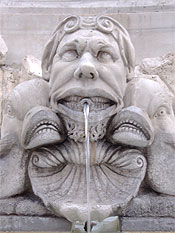 I discovered this face on the Pantheon Fountain in Rome. Look into its eyes. What emotion do you see? Fear? For much of history, the average man lived in fear. During Ancient Times, empires killed or enslaved humans. During the Middle Ages when feudalism prevailed most people were considered to be property and lived in fear of their owners. The Modern Age began around the time the Pantheon Fountain was designed by Jacopo della Porta in 1570. During the Modern Age, human rights expanded dramatically. Today, it’s unfathomable that four decades ago, African-Americans had to attend separate schools, sit in the back of public buses, drink from separate water fountains and were not allowed to dine at many restaurants.
I discovered this face on the Pantheon Fountain in Rome. Look into its eyes. What emotion do you see? Fear? For much of history, the average man lived in fear. During Ancient Times, empires killed or enslaved humans. During the Middle Ages when feudalism prevailed most people were considered to be property and lived in fear of their owners. The Modern Age began around the time the Pantheon Fountain was designed by Jacopo della Porta in 1570. During the Modern Age, human rights expanded dramatically. Today, it’s unfathomable that four decades ago, African-Americans had to attend separate schools, sit in the back of public buses, drink from separate water fountains and were not allowed to dine at many restaurants.
As human value has increased, so too has economic prosperity. When people are treated with respect, have a sense of belonging to the society they live in, and have access to educational and occupational opportunities, they feel valued and are more likely to thrive.
What might tomorrow bring when it comes to human value?
There is reason to believe human value will increase in the workplace given the coming labor shortage and competitive pressures of globalization. Employers will need to increase human value to attract and retain the people they need to meet market opportunities. And what might the workplace look like if human value increases in the years and decades ahead? Perhaps more people will feel informed and that their ideas and opinions will be considered by decision-makers. Perhaps everyone will have a mentor to help them grow. As human value increases in the workplace, so too will employee engagement, productivity and innovation. Why not increase human value in your workplace today? If you’re a leader, how might you make the people you are responsible for leading feel valued? If you’re not in a leadership position, how might you help your colleagues feel valued?
Note: Leader to Leader published an article in its current edition that Jason Pankau and I wrote. The article is entitled, “Strengthening Human Value in Organizational Cultures.” This is an especially meaningful event for me because it is the first time my work has appeared in Leader to Leader, an award-winning leadership journal that has a connection to two of my heroes: Frances Hesselbein and the late Peter Drucker. Peter Drucker was the founder of Leader to Leader and Frances Hesselbein was a co-founder and has been its editor-in-chief. To find out more about Frances, pick of a copy of Fired Up or Burned Out where you will find a chapter on her miraculous turnaround of the Girl Scouts of the USA. To read the essay, “How Peter Drucker Changed My Life,” click on employee engagement.




